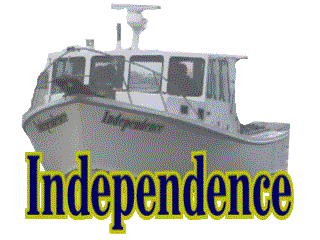

2001 Ayuruoca Photos
All images on this page © 2001 by Christina Young.
Welcome to the world of perpetual midnight -- the New Jersey Mud Hole! The Mud Hole is the deep, silty ocean trench running from the mouth of the Hudson River to the abyssal dropoff of the Hudson Canyon, over 80 miles offshore. Being in smack in the middle of the approaches to New York Harbor and the Port of Newark, it is filled with shipwrecks from the past 300 years. Most of these wrecks are difficult dives -- they are deep (ranging from 150 fsw to 250 fsw), covered with nets and monofilament, and very dark due to both the usually poor visibility (most of the time just a few feet) and silty bottom which absorbs most of the remaining ambient light. For these reasons, the majority of the wrecks here don't get visited very often and still have many interesting artifacts.
The Ayuruoca (Oil Wreck) lies in 170 fsw, and is the most popular Mud Hole wreck. It is certainly one of my favorite wrecks, because of its size (468 feet in length), the fact that it is intact, has many interesting penetrations, lots of nooks and crannies in every part of the wreck (like little shacks, strange pieces of machinery, booms and trucks lashed to the decks), and nice artifacts (everything from cookware and china, to beautiful brass pieces).
The Ayuruoca was a Brazilian freighter sliced in two in 1945 by the Norwegian freighter General Fleischer. It lies NW-SE in two pieces about 300 feet apart. Interestingly, none of the WWII Mud Hole wrecks were U-boat kills! Since ships would run with their lights out at night to avoid the U-boats, they would all just crash into each other and sink. It is also called the Oil Wreck because for years bunker oil was leaking out of its fuel tanks little by little.
The private dive boat Independence is a 33-foot BHM that cruises up to 25 knots. This boat is especially outfitted for deep wreck diving expeditions far offshore.
The following pictures (all images from video) are from voyage of the Independence to the Ayuruoca's bow section, Sunday, July 29, 2001.
| Here's the crew today - Mark Nix, Richie Kohler and John Chatterton. Mark can't wait to get back, as he's already checking his watch even as we leave the dock on the way out. ;-) |  |
 |
Dan Bartone navigates his way through the canals on the way out to Manasquan Inlet. We were supposed to go to the SS Carolina today, but the offshore forecast is poor. Instead we opt for the Ayuruoca, which is an inshore deep dive. |
| Once we get there, Richie Kohler gears up to go tie the hook into the wreck. | 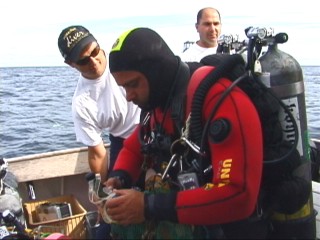 |
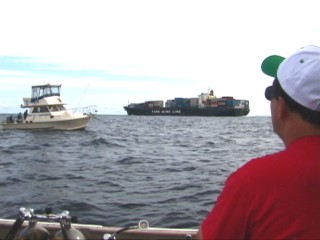 |
We are diving the bow today, as Captain Zero's boat, the John Jack, is on the stern. Freighter traffic passes all day long, sometimes just a little bit too close for comfort. The Ayuruoca lies smack in the middle of the approaches to the Port of Newark, one of the world's largest and busiest container ports. You definitely don't want to do a free ascent here! |
| This is a large search light on top of the forward superstructure. It's completely overgrown with anemones. |  |
 |
A nice, bronze porthole backing plate near the bridge. |
| This is an empty pedestal for bridge equipment. All of the bridge equipment itself was removed decades ago. |  |
 |
Another empty pedestal in the bridge. |
| Descending into the forward hold nearest the superstructure. |  |
 |
I pass a railing at the end of my dive on the way back to the anchor line. |
| Looking up at the anchor line coming down against the forward superstructure. By Mud Hole standards, visibility and lighting conditions were excellent up high on the wreck. | 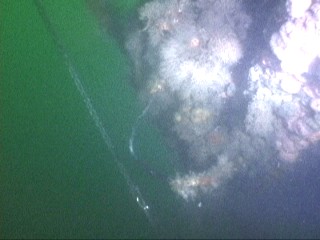 |
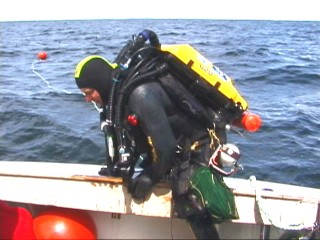 |
John Chatterton climbs back on the boat at the end of his dive. |
|
Dan Bartone comes back on board. |
|
 |
When we get back to the dock at the end of the day (at Dan's house), Josephine eagerly awaits us. |
|
On this Ayuruoca trip I found this brass wheel while digging in the rubble in the captain's office. The numerical digits '0' through '9' around the rim are recessed into the brass and filled with rubber. What do you think it is? I've had two suggestions - a printing device used for the cargo manifest, and a rotary indicator of some type. This is what the artifact looks like after I cleaned it up by soaking it in muriatic acid and polishing it with a soft brass brush. When I found it, it was an unrecognizable piece of junk that the untrained eye would easily dismiss and throw away. |
|
![]()
Back to Home | Back to Photos | Back to Scuba Photos | E-mail Me